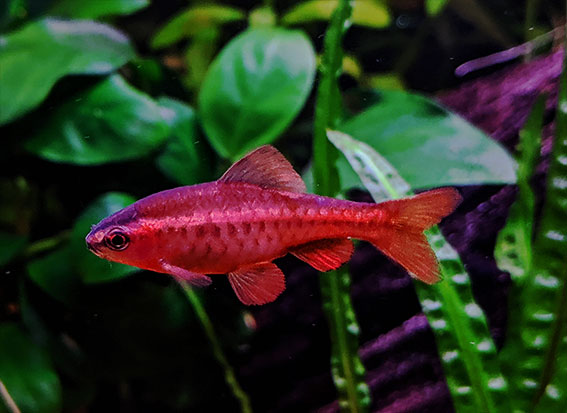Cherry Barb fish (Puntius titteya) is highly regarded by aquarists worldwide as one of the most attractive freshwater fish species. These barbs are well-known for their vivid colors and calm behavior which gives a captivating charm to any aquarium. In this comprehensive guide, we delve into the intricate details of Cherry Barbs, including their characteristics, origin, care needs, and breeding.

| Scientific Name | Puntius titteya | |
| Common Name | Cherry Barb | |
| Origin | Sri Lanka | |
| Life expectance | 4-6 years | |
| Size | Typically 1.5 to 2 inches in length | |
| Color and marking | Cherry-red with iridescent golden accents; black horizontal stripe | |
| Tank size | Minimum tank size of 20 gallon | |
| Temperament | Rarely aggressive, spending time swimming peacefully among tankmates | |
| Social behaviour | Shoaling fish, prefer being kept in groups of six or more individuals for security and interaction | |
Characteristics:

Cherry Barbs have a striking appearance characterized by elongated bodies covered in bright hues.
Despite their small size, Cherry Barbs are energetic and elegant swimmers, often stalking and exploring different areas of the aquarium. In their native environment, Cherry Barbs are shoaling fish, establishing tight-knit groups for safety and social interaction.
Cherry Barbs are widely recognized for their hardy nature, enabling them to flourish in a diverse range of water conditions. These fishes can withstand different variations in water.
Origin:
Native to Sri Lanka, Cherry Barbs resides in slow-moving streams, rivers, and ponds rich in vegetation. Their natural habitat consists of vegetated areas, providing sufficient hiding spots and protection against predators.
Size:
Cherry Barbs’ size typically reaches up to 1.5 to 2 inches (3.8 to 5.1 cm) in length, making them ideal for medium to small-sized aquarium setups. Their modest size allows for comfortable accommodation in community tanks without imposing territorial conflicts.
Life Span:
Cherry Barbs’ lifespan average is 4 to 6 years in captivity when given the best quality care.
Colors and Markings:

The most notable feature of Cherry Barbs lies in their bright coloration, mainly distinguished by a rich cherry-red hue.
Although both males and females possess a rich cherry-red hue, males tend to display more intense red tones marked with golden highlights, particularly when they are courting or during the breeding season.
A prominent black stripe extends horizontally from the gills to the tail, adding contrast to their vivid hues.
Right Aquarium Size:
Considering the cherry barb size, the best comfort zone is when they are housed in aquariums with a capacity of at least 20 gallons. Cherry barb tank size provides sufficient area for swimming space and facilitates the formation of territories within community setups.
Tankmates:

The peaceful temperament of cherry barbs makes them an excellent contender for community aquariums.
Cherry barb tankmates include other peaceful species such as tetras, rasboras, danios, and peaceful bottom-dwelling fish like Otocinclus catfish.
To prevent undue stress and harm, it is advisable to refrain from housing them with violent or fin-nipping species.
Cherry Barb Care:
Tank Size and Setup:
- Ensure the aquarium is properly cycled before introducing Cherry Barbs.
- To replicate the natural habitat of the Cherry Barbs, it is recommended to include substrates of gravel and sand. Adding live plants such as Java Fern, Anubias, and Hornwort provides hiding spots and enhances water quality by absorbing nitrates.
Water Parameters:
- Water parameters must be stable to improve the overall health and well-being of Cherry Barbs. The perfect water temperature falls within the ranges of 74-79°F (23-26°C).
- Try to adjust pH level ranges within 6.5-7.5.
- Keep ammonia and nitrite levels at zero ppm, and nitrate levels below 20 ppm through regular water testing and partial water changes.
Lighting:
- Avoid excessive brightness as this can stress out them and diminish their vibrant coloration.
- Utilize a timer to establish a consistent lighting schedule, mimicking natural day-night cycles and promoting a stable environment.
Maintenance:
- It is suggested that you make routine water changes of 25-30% on a weekly basis to flush out gathered waste.
- It might be helpful to Vacuum the surface on each water change to get rid of debris and organic matter, ensuring a clean and healthy environment for Cherry Barbs.
Diet and Feeding:
Cherry Barbs are omnivorous by nature, displaying a hearty appetite for both plant matter and protein-rich foods. A well-balanced cherry barb diet should comprise live or frozen treats such as bloodworms, fish flakes, moina, brine shrimp, and daphnia.
Gender Differences:
Differentiating between male and female Cherry Barbs is relatively straightforward. Males generally have more vivid pigmentation, especially during breeding displays.
Furthermore, males tend to have more slimmer body structures and exhibit more pronounced fin extensions, notably in the dorsal and anal fins.
Comparatively speaking females display a rounder belly, especially when pregnant, and feature less intense coloration.

Breeding:
Here are essential steps to facilitate successful breeding:
- Separate Breeding Pair:
Select a healthy male and female pair and shift them to a separate breeding tank that is furnished with dense vegetation or spawning mops to serve as spawning sites. This ensures privacy by encouraging the breeding of cherry barbs and cherry barb eggs.
- Spawning Ritual:
Cherry Barbs are egg scatterers, with females depositing adhesive eggs among the plant foliage. Males engage in elaborate courtship displays, showcasing vibrant colors and fin flaring to entice females into spawning.
- Egg Incubation:
To avoid egg predators, remove the adult fish as soon as spawning takes place. The hatching period of the egg is generally between 24 to 36 hours.
Conclusion:
Cherry Barbs epitomize the perfect blend of beauty and tranquility, making them prized additions to freshwater aquariums.
By understanding their unique characteristics, care requirements, and breeding nuances, aquarists can embark on a fulfilling journey of nurturing these captivating fish.
With proper attention and dedication, Cherry Barbs thrive, enchanting observers with their radiant presence for years to come.


